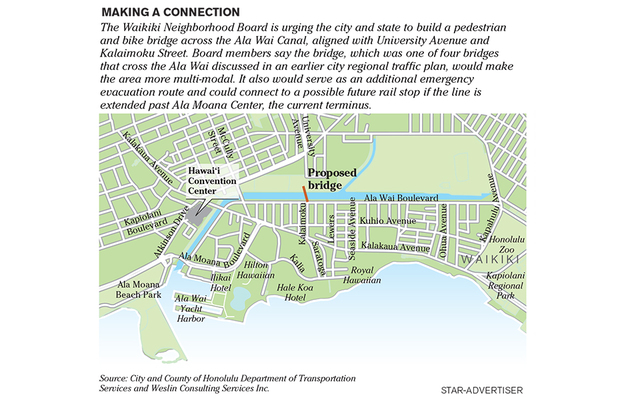The Waikiki Neighborhood Board is urging the city and state to kick-start a plan to build a pedestrian and bicycle bridge that crosses the Ala Wai Canal linking Waikiki to the University of Hawaii at Manoa and nearby neighborhoods.
The board passed a resolution 12-3 Tuesday to support building a limited-purpose pedestrian and bicycle bridge that would connect Waikiki to the University Avenue area. While board members did not specify an exact location, the 2013 Waikiki Regional Circulator plan discussed linking University Avenue and Kalaimoku Street. That plan, which was funded by the city and the Federal Highway Administration, aimed to add crossings and make other improvements that would aid bicyclists and pedestrians so they would not have to travel out of their way and could avoid dodging traffic or long waits at busy intersections. Sites for six potential pedestrian and bicycle bridges, including four that crossed the Ala Wai, were identified as necessary to link Waikiki to Ala Moana, Kakaako, McCully, Moiliili and Kaimuki — forming a nearly 8-mile pedestrian and bike network.
Waikiki Neighborhood Chairman Bob Finley said many on his board have long favored a University Avenue area crossing, which it believes would improve safety and serve as a draw for tourists and residents.
“We think it’s a great idea and many of us have been frustrated by the delay in getting this started,” Finley said.
Finley said the board renewed its interest in the project late last year when the Department of Emergency Management updated its tsunami evacuation zone map, showing that a super tsunami could require evacuation all the way to King Street. Supporters want to see a bridge running before Bikeshare Hawaii comes to Waikiki. They also want to prepare for a possible future rail stop if the line is extended past Ala Moana Center, the current terminus.
Supporters like Waikiki Neighborhood Board member Jeff Merz say such a bridge would improve community aesthetics as well as traffic conditions and the general health and well-being of the community.
“This is about emphasizing pedestrians and bikes and de-emphasizing vehicles, which are detrimental to our physical health and cause air pollution,” Merz said “This isn’t just about University Avenue. This would impact the entire region. It truly turns the Ala Wai Canal into not just a drainage dump, but a feature.”
Finley said moving the project forward now presents an opportunity for a funding partnership with Hawaiian Electric Co. The utility was recently ordered by the state Department of Land and Natural Resources to bury one of its underwater cables deeper in the Ala Wai Canal to avoid impeding future dredging.
“The cost of the bridge is estimated at about $5 (million) to $11 million,” Finley said. “Perhaps Hawaiian Electric could use the bridge to attach its cables and share in the cost.”
HECO spokesman Peter Rosegg said the utility has begun an environmental assessment on the burial, but would be open to partnership discussions if there was movement on the bridge.
“Attaching to the bridge would be easier and less expensive,” Rosegg said. “As part of the environmental assessment currently in progress, we are evaluating installing the cable (in a ductline, essentially a pipe) under a pedestrian bridge.”
Rick Egged, president of the Waikiki Improvement Association, said the board’s resolution and the potential to create synergies with HECO provide another opportunity to get the concept on the radar of city and state decision makers. Even if efforts ramp up now, Egged said it would still be 2018 or 2019 before construction could start.
“We’ll try to get traction in the city and then work on selling the concept to neighborhoods like Moiliili and McCully,” Egged said.
The bridge has garnered support in Waikiki, but the idea has been viewed more negatively in mauka neighborhoods. During a March 27, 2014, public hearing , 60 percent of testifiers supported a limited-use bridge. However, more than 75 percent of these supporters lived in Waikiki, McCully–Moiliili Neighborhood Board Chairman Ron Lockwood said Tuesday in testifying against the measure before the Waikiki Neighborhood Board.
“(Our board) has voted against such a bridge in 1997, 1999, 2002, 2003, 2004, 2005 and 2007,” Lockwood said.
Lockwood said the Ala Wai Elementary School parent-teacher association, Iolani School, and the 500 University AOAO also are opposed. The Ala Wai Manor condominium board had been opposed to the concept in 2007, but the current board has not taken a position.
“While I appreciate Waikiki residents expressing a desire to walk to work, the expending of $5 (million) to $11 million for a bridge for such a limited audience is wrong,” Lockwood said.
Linda Wong, vice chairman of the Diamond Head, Kapahulu, St. Louis Heights Neighborhood Board, dislikes the project, too.
“I like the mesmerizing drive down the Ala Wai. Looking at the water is one of the few things I’d like to keep in Waikiki,” Wong said.
——-
CLARIFICATION: The current Ala Wai Manor condominium board has not taken a stand on the proposed construction of a pedestrian/bike bridge crossing the Ala Wai Canal. The former Ala Wai Manor board was opposed to the concept in 2007. In a Page B5 story Thursday, McCully–Moiliili Neighborhood Board Chairman Ron Lockwood said the current Ala Wai Manor board opposed to the bridge.

